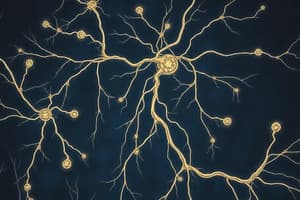Podcast
Questions and Answers
- Which system is able to detect a stimulus?
- Which system is able to detect a stimulus?
- pons
- CNS
- PNS (correct)
- midbrain
- What does the CNS comprise of?
- What does the CNS comprise of?
- brain and spinal cord, which integrates information and creates a response (correct)
- medulla and midbrain
- gyri and sulcus
- midbrain, spinal cord, cortex
- After the response is made, where does the response go and through which system?
- After the response is made, where does the response go and through which system?
- Response goes to only liver and heart
- Response goes to the brain, spinal cord and midbrain
- Response goes to the legs and arms only
- Response goes to muscles, glands and blood via the peripheral nervous system (motor) (correct)
- What part of the neuron receives a stimulus from a neuron or receptor?
- What part of the neuron receives a stimulus from a neuron or receptor?
- Which part of the neuron processes/integrates the stimuli?
- Which part of the neuron processes/integrates the stimuli?
- Which part of the cell passes along another stimulus if its stimulated enough?
- Which part of the cell passes along another stimulus if its stimulated enough?
- Where are axons carried in bundles?
- Where are axons carried in bundles?
- Where do majority of neuronal cell bodies reside?
- Where do majority of neuronal cell bodies reside?
- With the exception of which neuronal cells that do not reside in the CNS?
- With the exception of which neuronal cells that do not reside in the CNS?
- What is the function of the dorsal root ganglia?
- What is the function of the dorsal root ganglia?
Flashcards are hidden until you start studying




